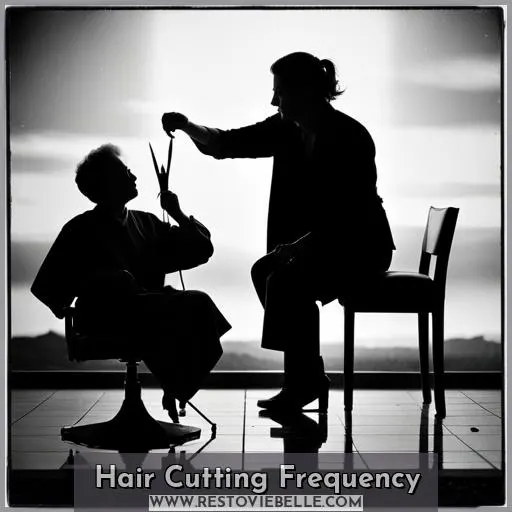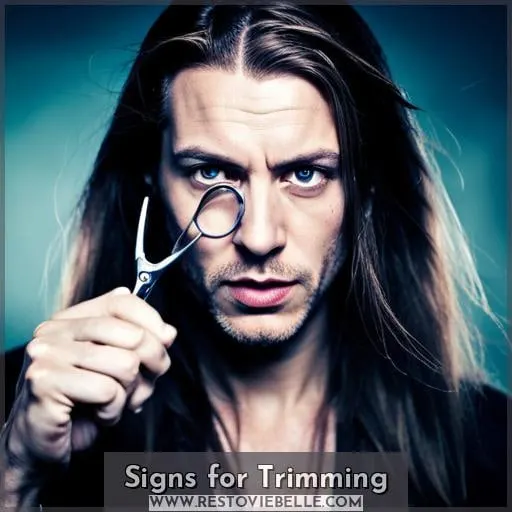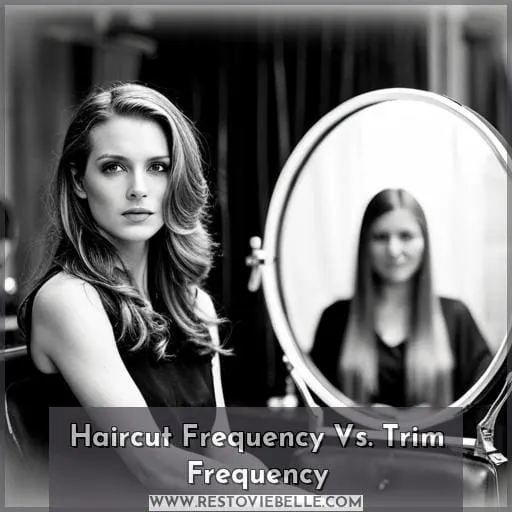This site is supported by our readers. We may earn a commission, at no cost to you, if you purchase through links.
 From time immemorial, the question of how often you should cut your hair has been posed. People fall into two categories: those who stick to a strict hair-cutting routine and those that go years between trims.
From time immemorial, the question of how often you should cut your hair has been posed. People fall into two categories: those who stick to a strict hair-cutting routine and those that go years between trims.
The type of hairstyle or ‘do you have can influence how frequently it needs maintenance. For instance, short haircuts such as bobs might require more frequent cuts than longer styles due to their shape easily becoming distorted over time.
Split ends are also another indicator that it’s time for some shearing – so if yours are looking worse for wear, then maybe head in sooner rather than later! Hair texture will also play a role in the required frequency, with coarse or fine locks needing different amounts of attention while chemically treated strands may call for more regular appointments compared to untreated ones.
Although many salons suggest scheduling visits every six weeks, these guidelines aren’t set in stone, so take all factors into consideration before booking your next appointment!
Table Of Contents
Key Takeaways
- Short hair: Trim every 1-6 weeks to maintain shape.
- Long hair: Trim every 3-6 months to keep vibrancy.
- Chemically treated or heat-damaged hair: Trim every 8 weeks.
- Regular trims: Prevent damage for all hair types.
Hair Cutting Frequency
You should seek professional advice to determine the appropriate frequency for maintaining your hairstyle, depending on your hair type and condition. The amount of time between trims varies with each individual’s hair texture, length, style preference, and even chemical treatments or heat styling techniques.
Split ends are a clear sign that it’s time to get a trim as they can travel up the shaft of the hair if left uncut over time. Regular haircuts help maintain healthy-looking locks by removing split ends while also promoting growth in most cases.
Depending on these factors, experts typically recommend getting a haircut every 3-4 months and more often for those with finer strands or chemically treated/heat damaged tresses – potentially every 6 weeks!
To maximize results at home, use quality products such as conditioners and heat protection sprays along with regular trims so you can achieve maximum radiance from your salon experience!
Factors Affecting Hair Cutting Frequency
It’s important to consider factors like hair condition and style when determining the appropriate frequency for your haircuts. Proper hair care, including using heat protection products, is essential in maintaining healthy locks and promoting growth.
Split ends are a common issue that can be prevented with regular trims every 6-8 weeks. However, different hair types require more or less frequent visits to the salon. For example, fine or coarse hairs may need trimming every 4-6 weeks, while curly strands can go up to 8-12 weeks between cuts.
Hairstylist recommendations should also come into play as they provide specific trim intervals depending on styles such as bangs (2-3 weeks) versus layered bobs (7 weeks).
Lastly, maintain consistent appointments at salons of your choice for quality services tailored towards achieving desired hairstyles, regardless of texture type and conditions.
Hair Types and Frequency
You’ve likely heard the old adage, get a haircut every six weeks, but when it comes to hair cutting frequency, there is no one-size-fits-all answer. Depending on your hair type – whether that’s short, medium, long, or thick; fine or coarse; straight, wavy, or curly/coily – you may need anywhere from weekly maintenance to quarterly trims in order to keep your style looking its best.
Short Hair
Maintaining your short hair every 1 to 6 weeks keeps it looking sharp and stylish. Regular trims prevent split ends, promote growth, and maintain shape. Use proper heat protection products to reduce damage from styling tools.
Avoid waiting more than six months for a haircut as this can lead to health issues with the hair, such as tangles and fraying split ends that travel up the shaft over time. Keep an eye out for signs of needing a trim like lost layer shape or dullness in appearance due to lack of care.
| Short Hair Care | Hair Health Tips |
|---|---|
| Heat Protection | Split End Prevention |
| Trim Intervals | Hair Trimming |
| Short Hair Trims | Hair Care Tips |
| Split Ends Prevention | Hair Styling Tips |
Medium Hair
For medium hair, trim every 6 to 12 weeks and adjust for growth. Incorporate color trends into your routine to switch up the look as needed. Also, consider texture care; coarse or thick hair may need a few months between trims, while fine strands should be trimmed more often due to fragility and split ends.
Growth patterns also play an important role in determining how often you should cut your hair. Longer styles require more maintenance, whereas shorter cuts can stand on their own with regular trims every 3-7 weeks (or even 2 if needed).
Make sure you’re using proper products such as conditioner or heat protection spray when styling with hot tools. Chemical treatments or haircuts require extra attention, so aim for 8-week intervals instead of waiting much longer than that! Finally, keep healthy habits like investing in quality haircare items, wearing protective styles at night, and combing out any tangles before washing/drying.
Long Hair
Keep your long hair looking vibrant by trimming it every 8 weeks to maintain shape. If you have curly or heat-damaged hair, you may need more frequent trims due to fragility and split ends. Regular haircuts are essential for healthy, glossy locks – no matter the length of your tresses! Invest in quality conditioners and thermal protection products that guard against breakage.
Thick Hair
You should refresh thick hair every few months, as it needs regular care despite infrequent trims. Use heat protection products when styling to prevent split ends and maintain layer shape. Seek professional advice on trim intervals that work best for your specific type of hair.
Consider consulting with a trusted team of experts or hairstylists to get the most out of your haircare routine and maximize health and growth benefits.
Thin Hair
Thin hair can appear dull in a few months, so consider how quickly it might be breaking. Proper thin hair care is key to preventing split ends and maintaining health. Regular trims every 6 weeks are ideal for fine strands, while heat protection products help avoid damage from styling tools.
Taking global initiatives into account when selecting products also helps ensure healthier locks overall; look for eco-friendly ingredients or brands that donate proceeds to clean water initiatives! To keep your thin tresses looking their best, incorporate the right balance of trim frequency and quality hair care items into your routine.
Coarse Hair
It’s important to give coarse hair the right amount of care, trimming it every few months for the best results. For maximum hair health and growth rate, layer trimming is recommended every 8-12 weeks. Split ends can be prevented with regular trims, while dyeing effects should not be ignored as they can damage your locks quickly.
Here are some tips for taking care of this unique hair type:
- Straight Hair Care – Trim at least once every 10-12 weeks.
- Wavy Hair Care – Refresh layers about every 6-8 weeks.
- Curly Hair Care – Get trims twice a year or quarterly.
Proper products and frequent attention to detail will ensure that coarse hair remains healthy and beautiful!
Fine Hair
Your fine locks may need a trim every 6 weeks to keep them looking healthy and vibrant. Split ends can travel up the hair shaft over time, so it’s important to get regular trims. Fine strands are more prone to breakage than other types of hair, especially if they’re heat-damaged or styled in high-maintenance styles like bangs or layers.
Professional advice is key when caring for your fine locks; seek out experts who understand curly and short haircuts as well as long hair.
Straight/Wavy Hair
For Straight/Wavy hair, trim every 10 to 12 weeks for an enviable look. Heat styling can cause split ends that require more frequent trims than normal. Incorporate professional advice and proper haircare products into your routine to ensure maximum hair health.
Medium-length hair trims should be done every 6–8 weeks while textured hair trims vary depending on the length of your haircut vs how quickly it grows out; short haircuts need more upkeep than long ones! Haircuts for different types also depend on the individual’s needs and preferences, so consulting a stylist is key in getting a cut tailored just for you.
Don’t wait too long between cuts or else you may suffer from breakage due to dryness – keep up with regular maintenance appointments as needed!
Curly Hair
Keep your curls looking their best by scheduling trims around 12 weeks. Professional advice should be sought for the frequency of haircuts, as coily hair needs special care and can be more fragile than other textures.
Split ends travel up the shaft over time, so regular maintenance is important to prevent damage from heat styling or chemical treatments. Celebrity hairstylists suggest a proper hair care routine that includes conditioner and heat protection products to promote growth while rehabilitating damaged hair.
Coily Hair
Coily hair typically requires trims every 12 weeks to ensure healthy, vibrant locks. Regular maintenance is essential, as coily textures tend to be drier and more fragile than other types of hair. Incorporate trimming tips into your care practices for best results – like cutting single-strand knots instead of using scissors on the bulk of the curl pattern – or seek advice from an experienced stylist if needed.
When it comes to style goals, don’t forget that frequent trims help keep curls full and prevent split ends from traveling up the shaft over time; this maintains length while promoting growth despite common misconceptions about its effects on strands! With regular upkeep, you can achieve beautiful coils worthy of admiration.
Specific Styles and Conditions
Whether you have a layered cut near your face, bangs, short haircuts, and bobs, or chemically treated hair that needs extra care – the frequency of cutting your hair depends on many factors. From heat-damaged locks to buzz cuts and fades – regular trims are key in maintaining healthy-looking tresses as well as the desired style.
Layers Near Face
Trim your layers near the face every 6 to 8 weeks for a fresh, stylish look. To avoid split ends and heat damage, use professional products and tools for frizz control. Keep an eye on hair length – if it’s growing too fast or too slow, you may need more frequent trims.
Don’t be afraid of a regular haircut; done correctly, it can actually promote healthy hair growth! When the time comes around, don’t hesitate: treat yourself to that salon appointment or trim with confidence at home.
Bangs
Time for a trim? Refresh your bangs every 2 weeks or 3 to 4 weeks to maintain their shape and style. To prevent split ends, chemical damage, and promote healthy hair growth, use proper products; adjust frequency as needed; get regular trims.
A few tips include investing in heat protectants; avoiding over-washing/over-brushing; moisturizing the scalp regularly.
Short Haircuts and Bobs
For short haircuts and bobs, trimming every 3 to 7 weeks is essential. This helps maintain the shape while avoiding detrimental damage such as split ends. Hair texture, regular care with heat protection products, and individual style goals should all be taken into account when deciding how often to cut hair.
A balanced approach that takes these factors into consideration will ensure a healthier head of hair without sacrificing style freedom or longevity.
Chemically Treated Hair
Chemically treated hair may need more frequent trims to maintain its health and radiance. Chemical damage can cause split ends, so it’s important to trim your hair every 8 weeks if you have had any chemical treatments.
An expertly-done cut is essential for keeping up with the damage that chemicals can do and maintaining the shape of your style. Prioritize finding a stylist who understands how to cut chemically damaged hair.
Use proper products like heat protection spray before styling. Look out for signs such as split ends or tangles that indicate a trim is overdue.
The Safe Home Lead Test Kit offers trilingual instructions, which makes testing easier than ever – ensuring you’re doing all you can to take care of yourself!
Heat-Damaged Hair
More frequent trims are essential when it comes to heat-damaged hair. Regular care can help curb breakage and enhance its health. Heat styling can cause split ends that travel up the shaft over time, so regular trims ensure healthy hair growth.
Lead testing technologies, like Safe Home’s patented test kit, detect dissolved lead levels down to 5 parts per billion for accurate results. The company also donates a portion of their sales to global water initiatives as part of their commitment towards environmental safety and cleanliness.
With proper products and timely trimming intervals, you’ll be able to maintain your mane in optimal condition even with frequent heat styling!
Buzz Cuts, Bangs, Cut-Outs, Fades
Refresh your buzz cut, bangs, cut-outs, or fades every 2 weeks to keep them looking sharp. Maintain the shape of your cut-outs and control flyaways with regular trims. Keep texture in check with a few snips on the edges for short styles.
For longer ones, it’s important to maintain evenness and preserve the health of hair strands that are prone to breakage due to heat styling. Invest in quality products like conditioner and heat protection sprays as they play an important role in maintaining bangs’ shine between cuts while also protecting from fading color treatments.
Layered Hair
Keep your layered look fresh by trimming it every 8 to 12 weeks. Split ends, lost shape, and heat-styled hair are all signs that you’re due for a chop. Fine or coarse hair may need more frequent trims to maintain its health and radiance.
Regular cuts help keep split ends away while promoting growth of healthy strands. They also ensure the layers stay in place as desired! Your hairdresser can provide advice tailored specifically for your locks if needed – don’t be afraid to ask questions about maintaining your signature style! With proper care, you’ll find yourself looking sharp with each passing season.
Signs for Trimming
It’s important to be aware of the signs that indicate it’s time for a trim. Split ends, lost layer shape, tangles, and fraying are all indications that your hair needs some TLC. Recognize these tell-tale signs early on and schedule regular trims in order to keep your style looking sharp and healthy.
Split Ends
Regularly check for split ends as they’ll travel up the hair shaft over time. Split ends can occur due to wear and tear, styling products, heat tools, or environmental damage. Trimming them is important for breakage prevention and maintaining healthy hair growth.
Ensure trimming is done properly to avoid further damage. Seek professional advice on the best styling options that suit your hair type and needs. For optimum health, we suggest cutting every 4-8 weeks depending on the condition – fine or coarse.
Taking proper care with regular trims will keep split end development at bay while keeping you looking stylish all year round!
Lost Layer Shape
Shape up your layers every few weeks to keep them looking fresh and vibrant. Regular trims help prevent split ends, maintain hair health, and promote growth rate. Professional advice should be sought out based on the type of hair you have; heat styling can cause damage that may require more frequent trims.
Here are a few tips for keeping your layers in check:
- Use proper conditioning products for the best results.
- Trim often enough so that shape is maintained but not too frequently as this can lead to breakage.
- Pay attention to signs of tangles or fraying which indicate it’s time for a trim.
- Avoid excessive heat styling and use protection when necessary.
To ensure healthy locks with excellent shine, don’t wait over six months between haircuts!
Tangles
Tangles can be a sign that it’s time for a trim, so don’t wait until your hair is unmanageable to book an appointment. Split ends, heat-styled hair, and regular trims are all key parts of maintaining healthy locks.
They help protect against damage and keep strands looking their best. Professional advice tailored to individual needs should also be taken into consideration when deciding how often haircuts should occur for optimal results.
Hair care products like conditioner and heat protection must also factor into the equation as part of proper maintenance techniques. These will influence growth patterns and style longevity, which need adjusting depending on the type or texture you have.
Keep an eye out for signs such as split ends traveling up the shaft over time or fraying at the roots.
Fraying
Fraying can be a sign that it’s time for your trim – check for split ends traveling up the hair shaft.
To maintain healthy hair, consider:
- Your choice of trim based on strand breakage and texture.
- The frequency with which you need to cut your hair (every 3 to 4 months).
- Whether or not you should seek professional advice about haircuts depending on type and needs.
The key is to understand how often your locks require maintenance while ensuring that split ends don’t travel far up the shaft!
Taking into account factors like heat styling, chemical treatments, and individual style goals will help ensure optimal health of both scalp & strands alike!
Hair Health and Growth
It’s important to maintain regular haircuts for split ends prevention and hair health. Depending on the type of your hair, you may need more frequent trims than others. To ensure a healthy head of locks, it is recommended that coarse or chemically treated hair should be trimmed every 8 weeks, while fine or heat-styled tresses can benefit from even more frequent cuts.
Frequent Trims for Split Ends Prevention
Regular trims keep your hair healthy and vibrant, preventing split ends from traveling up the shaft over time. Proper hair care products, like conditioner and heat protection, are essential for maintaining strong, beautiful locks.
Hair care experts, such as Katie Berohn, provide helpful advice on various practices to ensure optimal growth of your tresses.
For those who wish to go beyond basic maintenance tips into deeper lead testing analysis, EnviroTestKits offers revolutionary technology with patented accuracy down to 5-parts-per-billion. This technology is backed by scientists with 150+ years of experience in water testing and treatment solutions.
Hair Types Requiring More Frequent Trims
If you have fine, coarse, dyed, or heat-styled hair, don’t wait too long between trims – better to be safe than sorry! Chemical effects and split ends can damage your hair health over time.
- Deep condition regularly with natural ingredients like honey and avocado masks.
- Use leave-in conditioner before styling with heated tools.
- Invest in quality shampoo that won’t strip away moisture from the scalp. Regimen is important; more frequent cuts may be necessary depending on individual needs to maintain optimal hair health.
Expert Advice
For expert tips on hair care, look no further than Katie Berohn’s insights. The renowned hairstylist has a wealth of knowledge when it comes to maintaining hair health and growth, from split ends to home trimming and professional advice.
To limit split ends from traveling up your hair shaft over time, she recommends frequent trims every 6-8 weeks – depending on your individual type, of course! For those who have chemically treated or heat-damaged tresses that are fragile in nature, they should be trimmed every 8 weeks for best results.
And if you’re looking for something more hands-on with home trimming, don’t forget about investing in the proper products such as conditioners and heat protection.
So don’t wait too long before you book that appointment – regular upkeep is key for achieving beautiful manes inside out!
Maintenance Tips
With regular trims and proper hair care products, you can maintain the health of your hair and achieve the desired style. Hair care is an essential part of taking care of yourself as it influences growth and helps shape your look.
With these maintenance tips in mind, trimming frequency can be adjusted to suit individual needs.
Use Proper Hair Care Products
You can’t go wrong with investing in quality hair care products like conditioners and heat protection – it’s key to keeping your locks looking luscious. Opt for natural ingredients over chemical ones, as they provide better nutrition.
Brushing techniques should be tailored towards different hair types, so seek professional help if needed. Split ends happen when the protective part of our strands is damaged; prevent them by avoiding harsh DIY tips and maintaining a healthy hair care regimen.
Regular trims don’t just keep you stylish but also promote growth while preventing further split ends or damage from occurring – an essential step for any routine!
Hair Care Influences Growth and Style
Adjusting your hair care routine according to your specific style and needs helps keep your locks looking their best.
- Utilize products designed specifically for the texture of your hair; these can provide extra protection from heat styling, chemicals, or other damage.
- Be mindful of split ends and trim them regularly to avoid further damage. This is especially important for finer strands, which may need more frequent trims.
- Consider incorporating a deep conditioning treatment into your weekly routine if needed. This will help ensure optimal hydration levels depending on the type of product used.
- Flexibility in how often you should adjust styling techniques based on the current state of your locks. What worked before might not work now! Ultimately, understanding one’s own unique hair type and style is key to enjoying its full potential beauty while preventing any lasting harm from neglectful practices.
Regular Trims for Hair Health
Trimming your hair regularly helps maintain its health and radiance. Experts recommend trimming every 6 to 8 weeks, preventing split ends and promoting growth. Use proper hair care products, like conditioner or heat protection, for fine hair damaged by styling.
Vary the frequency based on your individual needs. Thick or coarse hairs require less frequent trims than thin or chemically treated hairs.
| Hair Type | Frequency |
|---|---|
| Short | 1-6 Weeks |
| Medium | 6-12 Weeks |
| Long | 3 – 6 Months |
| Thick | A Few Months |
| Thin | Every 6 Weeks |
| Coily | 12 Weeks |
| Fine | Every 6 Weeks |
| Straight/Wavy | 10 – 12 weeks |
Ensure regular trims to prevent tangles, fraying, and lost layer shape as split ends travel up the shaft over time, even with proper maintenance!
Haircut Frequency Vs. Trim Frequency
Frequency of haircuts and trims depends on your hair type, condition, and style. Here’s a 4-item list to consider:
- Hair Type: Fine hair may need more frequent trims, while thicker or coarser types require less.
- Condition: If chemically treated or heat styled, you should trim every 8 weeks for healthier hair.
- Style Goals: If you want layers near the face, make sure to trim every 6 to 8 weeks for best results.
- Expert Advice: Follow advice from experts like Katie Berohn, who understands different styles and needs when it comes to care practices.
When considering how often you should cut your hair, keep in mind that regular cuts are essential not only for maintaining shape but also for health, as split ends travel up the shaft over time if left untreated.
It’s important, regardless of what kind of cut or style you have, to get a proper trim once in a while. Using products such as conditioner regularly can help prevent split ends, which will promote growth.
Lastly, don’t wait too long between cuts – no more than six months – to ensure healthy-looking locks all year round!
Frequently Asked Questions (FAQs)
How often should I shampoo my hair?
Shampoo your hair regularly to maintain its health and luster; don’t overdo it, though, as too much can strip away its natural oils. Maintain a balance between cleansing and nourishing for the ultimate softness, shine, and body.
With thoughtful care, you’ll enjoy gorgeous locks that feel just as good as they look.
Is regular trimming necessary for my hair type?
Regular trims are essential for all hair types. They promote growth, prevent split ends, and keep your locks looking luscious! Get a professional opinion based on your type and needs to ensure you’re keeping your tresses at their best.
What are the best products to use for thinning hair?
If you’re looking for thinning hair solutions, look no further! Regain your confidence with products like volumizing shampoos and conditioners that nourish the scalp, leave-in treatments to strengthen every strand, and styling tools specifically designed for maximum lift.
Is there a difference between a haircut and a trim?
A haircut is a full cut of the hair, while a trim typically involves snipping off just split ends or maintaining the shape of existing layers.
How can I prevent hair breakage?
To prevent hair breakage, use quality products that nourish and protect your locks. Cut back on heat styling, opt for regular trims to remove split ends, and invest in a deep conditioning treatment every few weeks to maintain shine and strength.
Conclusion
You’ve learned the facts and tips for every hair type and style, so now it’s time to make a decision. As a general rule of thumb, it’s wise to cut your hair every 3-4 months. However, the frequency can vary depending on your hair type and condition.
For example, if you have short hair, you may need to trim it every 1-6 weeks. Similarly, for long, curly hair, you may only need to cut it twice a year. Additionally, if you have chemically treated or heat-damaged hair, you should get it trimmed at least every 8 weeks.
Lastly, if you have split ends or fraying, it’s a good idea to get them trimmed as soon as you can. By following these guidelines, you can ensure your hair remains healthy, vibrant, and stylish.














